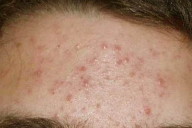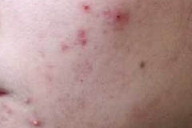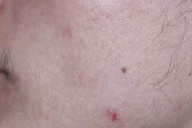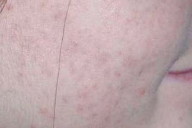How Long Does Azithromycin Take To Work For Acne
Azithromycin: A new therapeutical strategy for acne in adolescents
Federico Bardazzi MD, Francesco Savoia MD, Gianluca Parente Physician, Michela Tabanelli MD, Riccardo Balestri Doc, Giuseppe Spadola MD, Emi Dika MD
Dermatology Online Journal 13 (4): four
Department of Specialistic and Experimental Clinical Medicine, Division of Dermatology,University of Bologna, Italy.
Abstract
AIM: To study the efficacy, rubber, and compliance of 500 mg azithromycin thrice weekly for 8 weeks to treat acne vulgaris in adolescents. METHODS: An open-label, non-comparative study was carried out for viii weeks. Fifty-two teenagers with moderate to astringent papulo-pustular acne vulgaris were enrolled. Azithromycin, 500 mg orally thrice weekly for 8 weeks, was prescribed. No topical treatment was permitted. At the baseline visit, patients were scheduled to render at two-weekly intervals for viii weeks. Efficacy was gauged past the percentage clearance of papulo-pustular acne lesions. All patients were also evaluated at four months post-handling. RESULTS: A majority of patients (47/52) showed remarkable improvement in the first 4 weeks with a more than than xx percent reduction of their inflammatory papulo-pustular lesions. Maximum clearance was observed in 32 patients at 8 weeks. Slow improvement with eruptions of new lesions was seen in 6 patients. Agin events, such as heartburn and nausea, were reported by iii patients. All patients completed the 8-calendar week written report menstruation. The beneficial issue was maintained at four months subsequently the conclusion of treatment. CONCLUSIONS: Azithromycin, 500 mg thrice weekly for viii weeks, appears to exist a safe and constructive treatment for acne vulgaris in adolescents, with splendid patient compliance.
Introduction
Acne vulgaris is a common inflammatory disorder of the pilo-sebaceous follicles. Information technology is a multifactorial illness and its pathophysiology centers on the interplay of follicular hyperkeratinization, colonization with Propionibacterium acnes (PA), increased sebum product, and inflammation. This disease has a high prevalence, occurring mainly in adolescence. Although the peak of prevalence is effectually the 17th year of life, acne lesions can appear earlier and are not uncommonly observed in the age grouping ranging from 12 to 14 years, in which the status is underreported [1]. In a recent study the prevalence of acne amid teenagers in various European countries was calculated to range from seventy-87 per centum, according to different methods of classification [two]. Early on and adequate treatment helps to reduce psychological stress caused by acne lesions and the long-term risk of scarring. Diverse therapeutical options are bachelor in the handling of acne [3, 4, 5].
Antibiotic therapy has long been found useful in the management of moderate-to-astringent acne vulgaris. Mechanisms of action include suppressing growth of PA, reducing the production of inflammatory mediators, and acting in immunomodulation [half-dozen]. Commonly prescribed antibiotics include tetracyclines, doxycycline, minocycline, limecycline and erythromycin [5].
Recent research has been carried out to demonstrate the role of azithromycin in acne handling and its efficacy [7, eight, nine]. At that place are no reports in the literature of PA resistance to azithromycin [10].
We performed open-label, non-comparative study that was not sponsored by any pharmaceutical company, using an eight-week pulse-therapy regimen in adolescents who were non currently using whatever other topical or systemic treatment.
Methods
The primary focus of this written report was to appraise the efficacy, safety, tolerability and compliance of 500 mg of azithromycin thrice weekly for eight weeks in the treatment of acne in a cohort of boyish patients.
Azithromycin is an orally administered macrolide that has a wide spectrum of action. It is characterized by rapid and extensive uptake from the apportionment into intracellular compartments following oral administration and past a long one-half-life (68 h). The drug remains in the tissues for prolonged periods, from ii to 4 days, at levels college than the minimum inhibitory concentration for many common pathogens [eleven, 12], making azithromycin a promising alternative to conventional antibiotics.
L-two patients underwent a clinical session with a dermatologist during which a global assessment was made, including a full confront count of papular and pustular lesions [thirteen] (Table 1). The number of lesions was calculated at the beginning of the treatment (baseline, day i) and at 2-weekly intervals for 8 weeks (day fourteen-28-42-56). The difference between the number of lesions observed at baseline and the number seen in subsequent examinations was used to evaluate the efficacy of the therapy (Table two). A difference equal to or greater than 50 percent was considered "good-excellent", between xx and 50 percentage "moderate," and less than 20 percentage "poor".
Furthermore, all patients completed the dermatology life quality index (DLQI), a questionnaire that is simple to administer, reproducible, validated, and designed to be practical and of clinical value when used in a busy clinical setting [fourteen]. At every check-up we assessed the clinical response to the acne handling, any adverse events, and patient compliance.
Patients with relapsing acne previously treated with antimicrobials such every bit doxycycline, minocycline, lymecycline and erythromycin were eligible to be enrolled in the study after a six-month wash-out period. No patients had previously been treated with oral isotretinoin. The main exclusion criterium was a history of macrolide sensitization.
Azithromycin (500 mg thrice weekly for 8 weeks) was prescribed to the patients. No topical therapy was associated. Patients were advised not to undergo whatever beauty procedures, such every bit chemical peels, bleaches, or facials, during the study period.
All patients were also evaluated at a 4 calendar month, post-treatment follow-up visit. Only topical rinse-off cleaners were allowed during follow-upward.
Results
Fifty-2 adolescent patients were enrolled, 37 males and 15 females, ranging in age from 13 to 17 years and all suffering from moderate to severe papulo-pustular acne vulgaris. Forty-seven patients (90.4%) showed remarkable improvement within the first 4 weeks, with a significant reduction in their inflammatory papulo-pustular lesions (23 showed "moderate" reduction and 24 "proficient-excellent"). Maximum clearance was observed at 8 weeks (Tabular array iii)
 |  |
| Figure 1a | Figure 1b |
|---|
 |  |
| Figure 2a | Figure 2b |
|---|
 |  |
| Figure 3a | Effigy 3b |
|---|---|
| a Figures: earlier treatment b Figures: subsequently treatment | |
Pustular lesions showed a major degree of clearance, but comedones persisted as would exist expected. All sites showed an equal degree of clearance. Residual post-inflammatory pigmentation and pitted and linear scarring represented the aftermath of the relapsing blueprint of acne. Six patients (11.5%) showed "poor" results characterized by slow clearance with eruptions of new lesions whilst on treatment; they notwithstanding completed the eight-week treatment. Adverse events, such as heartburn and nausea, as a result of gastrointestinal intolerance, were reported by iii patients (5.8%). These patients were advised to employ the antacid, magnesium trisilicate, before meals. This successfully alleviated the symptoms.
All patients completed the 8-week study period. In 25 (78.1%) patients out of the 32 patients labeled as "expert-excellent responders," the beneficial event persisted during a follow-upwardly of 4 months without whatever therapy.
DLQI at the end of handling confirmed the improvement in the quality of life after 8 weeks of treatment in all the patients who obtained a reduction rated as "skilful-excellent". In the remaining patients the results of DLQI were variable and not related to the percentage of reduction in mean lesion count.
Discussion
Acne vulgaris is a mutual skin disorder among children and young adults that carries enormous financial and psychosocial impact. Approximately twoscore percent of adolescents below the age of xv years develop physiological acne and in 15 percent of these patients the acne is sufficiently troublesome to merit a visit to a dermatologist [two]. There is no doubt that early and acceptable treatment will reduce the severity of the problem and the long-term run a risk of scarring.
The choice of treatment depends on the clinical severity. A patient with mild acne should receive topical therapy. In moderate-to-astringent acne, systemic handling is required in most cases, using antibiotics, hormonal therapy, and oral retinoids [x, 15, 16]. As a first line systemic treatment in adolescence most authors recommend the utilise of systemic antibiotics, including tetracyclines, doxycycline, minocycline, limecycline and erythromycin [v, 6]. Recently, azithromycin has been added to this list [ix, 17]. Comparative clinical trials accept shown that the tolerability profile of azithromycin is superior to that of erythromycin and doxycycline [8]. Moreover, tetracyclines can cause both mucocutaneoeus and systemic agin furnishings [10].
The unique pharmacokinetics of azithromycin, together with its effectiveness, make information technology a highly suitable agent for the treatment of acne. The drug shows an affinity for inflammatory tissue and demonstrates activity against many anaerobic species, including PA. Clinical isolates of PA are known to be highly susceptible to azithromycin [19].
In selecting the appropriate antibiotic for patients, the clinician should take into business relationship the severity of the acne, the rubber profile of the drug, the potential for evolution of resistance, and the cost-effectiveness.
Azithromycin has many advantages compared to other antibiotics. It is more stable than erythromycin in depression gastric pH; it produces fewer gastrointestinal side-effects and presents no major drug interactions [xx]. Information technology also appears to exist safer than the new tetracyclines such as lymecycline, in pediatric patients. Finally, the possible efficacy of a less frequent dosage improves compliance, price-effectiveness and tolerability.
The widespread and long-term use of antibiotics over the years has unfortunately led to the emergence of resistant bacteria. Resistance to tetracycline and cantankerous-resistance to doxycycline are also common. The incidence of PA resistance in the United kingdom is estimated to exist approximately 65 percent for erythromycin and clindamycin and 40 pct for tetracycline and doxycycline [5], whereas there are no reports on resistance to azithromycin [10, 21, 22]. The global increase in the antibiotic resistance of PA may be a meaning contributing factor in treatment failures.
Recently some studies have been published on the effective apply of azithromycin in treating acne in adults, but until now there is scant published data on azithromycin utilize for acne in the adolescent population [7, 8, 9, 10, 17]. Our study confirms that azithromycin is a condom, effective, and tolerable antimicrobial agent with minimal side furnishings and practiced compliance, fifty-fifty in adolescent patients. Moreover, it is not photosensitizing; xv patients in this study were treated during the summer months with no photosensitivity issues. Azithromycin proved to exist successful inside 8 weeks of treatment in 88.5 percent of patients. Patient compliance was excellent and only three patients had gastrointestinal disturbances in the form of heartburn and nausea.
Differences betwixt the patients' personal assessment (DLQI) and the mean lesion counts are explainable by the fact that healed lesions often leave hyperpigmented macules, which patients evaluate every bit agile lesions; an boosted cistron may exist their excessive expectations.
All patients institute azithromycin like shooting fish in a barrel to take, and the majority found it constructive in controlling and immigration their acne. Peradventure, the ease of this pulse regimen contributed to patient and parental compliance.
No comment nigh absolute and relative toll of azithromycin treatment for acne can be made because the price of this medication is variable in every country. In Italian republic, National Health Service (NHS) distributes antibiotics to citizens costless of charge. Still, considering the cost imposed by this institution for these drugs, the cost of eight weeks of therapy with azithromycin (3-250 mg tabs/week) would be 137,68 €. This is higher than the cost of therapy with doxycycline (100 mg BID), which would be 23,46 €. In the U.s.a., the typical retail cost for 8 weeks of generic azithromycin therapy nether the suggested regimen would be approximately $440, although unlike chemist's prices may vary widely. Because there are patients who do not respond to or tolerate the tetracyclines, nosotros remember that azithromycin is a valid alternative.
Finally, a few studies accept compared azithromycin with other antibiotics [ten, 22, 23], but there are no data about the optimum dose of azithromycin for treating acne in adolescents or in adults. Further randomized, controlled comparative trials are needed to assess this signal, and to establish the duration of the treatment in patients with acne.
References
one. Herane MI, Ando I. Acne in infancy and acne genetics. Dermatology 2003, 206:24-28. PubMed
2. Leyden JJ. Therapy for acne vulgaris. Northward Engl J Med 1997, 336:1156-1162. PubMed
iii. Leyden JJ. A review of the use of combination therapies for the treatment of acne vulgaris. J Am Acad Dermatol 2003, 49(Suppl 3):S200-S210. PubMed
4. Smolinski KN, Yan Air-conditioning. Acne update: 2004.Curr Opin Pediatr. 2004 Aug;16(four):385-91. PubMed
5. Gollnick H, Cunliffe W, Berson D, et al. Management of acne: a report from a global alliance to improve outcomes in acne. J Am Acad Dermatol 2003, 49(Suppl 1):S1-37. PubMed
6. Tan AW, Tan HH. Acne vulgaris: a review of antibiotic therapy. Expert Opin Pharmacother. 2005 Mar;6(3): 409-xviii. PubMed
7. Duran JM, Amsden GW. Azithromycin: indications for the future? Expert Opin Pharmacother. 2000 Mar;1(3): 489-505. PubMed
eight. Kapadia North, Talib A. Acne treated successfully with azithromycin. Int J Dermatol. 2004 Oct;43(10):766-7. PubMed
nine. Caputo R, Barbareschi M, Veraldi S. Azithromycin: a new drug for systemic treatment of inflammatory acneic lesions. G Ital Dermatol Venereol. 2003;138:327-331.
x. Kus Due south, Yucelten D, Aytug A. Comparison of efficacy of azithromycin vs. doxycycline in the handling of acne vulgaris. Clin Exp Dermatol. 2005 May;30(three):215-20. PubMed
11. Hardy DJ, Henesey DM, Beyer JM, et al. Comparative in vitro activities of new 14-, 15-, and xvi-membered macrolides. Antimicrob Agents Chemother 1988; 32: 1710-1719. PubMed
12. Neu HC. Clinical microbiology of azithromycin. Am J Med 1991; 91 (Suppl. 3A): 12S-18S. PubMed
13. Witkowski JA, Parish LC. The assessment of acne: an evaluation of grading and lesion counting in the measurement of acne. Clin Dermatol. 2004 Sep-Oct;22(five):394-7 PubMed
xiv. Finlay AY, Kahn GK. Dermatology Life Quality Index (DLQI): a simple practical measure for routine clinical utilize. Clin Exp Dermatol 1994; 19:210-six. PubMed
15. Barnes CJ, Eichenfield LF, Lee J, Cunningham BB. A practical approach for the apply of oral isotretinoin for infantile acne. Pediatr Dermatol. 2005 Mar-Apr;22(2):166-9. PubMed
16. Brecher AR, Orlow SJ. Oral retinoid therapy for dermatologic weather in children and adolescents. J Am Acad Dermatol 2003, 49:171-182. PubMed
17. Fernandez-Obregon AC. Azithromycin for the treatment of acne. Int J Dermatol. 2000 Jan;39(ane):45-50. PubMed
xviii. Hopkins S. Clinical toleration and safe of azythromycin. Am J Med 1991; 91: 40S-5S. PubMed
19. Scheinfeld NS, Tutrone WD, Torres O, Weinberg JM. Macrolides in dermatology. Clin Derm 2003; 21: forty-9. PubMed
20. Alvarez-Elroco S, Enzler MJ. The macrolides. erythromycin, clarithromycin, and azithromycin. Mayo Clin Proc 1999; 74: 613-34. PubMed
21. Ross JI, Snelling AM, Carnegie E, et al. Antibiotic-resistant acne: lessons from Europe. Br J Dermatol 2003, 148:467-478. PubMed
22. Rafiei R, Yaghoobi R. Azithromycin versus tetracycline in the treatment of acne vulgaris. J Dermatolog Treat. 2006;17(iv):217-21. PubMed
23. Parsad D, Pandhi R, Nagpal R, Negi KS. Azithromycin monthly pulse vs daily doxycycline in the treatment of acne vulgaris. J Dermatol 2001; 28: 1-4. PubMed
© 2008 Dermatology Online Journal
Source: https://escholarship.org/uc/item/3qf1x5t6

0 Response to "How Long Does Azithromycin Take To Work For Acne"
Post a Comment